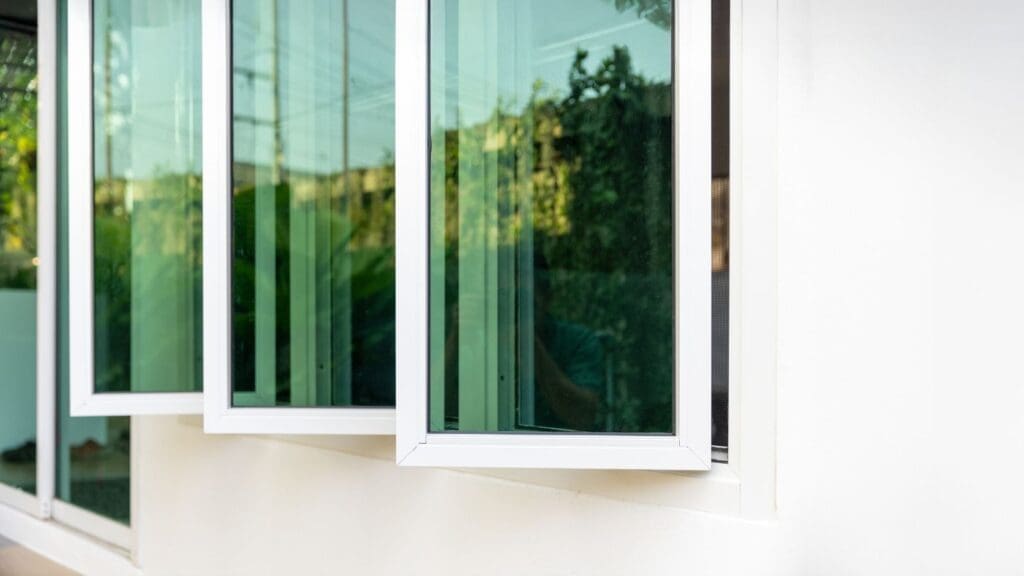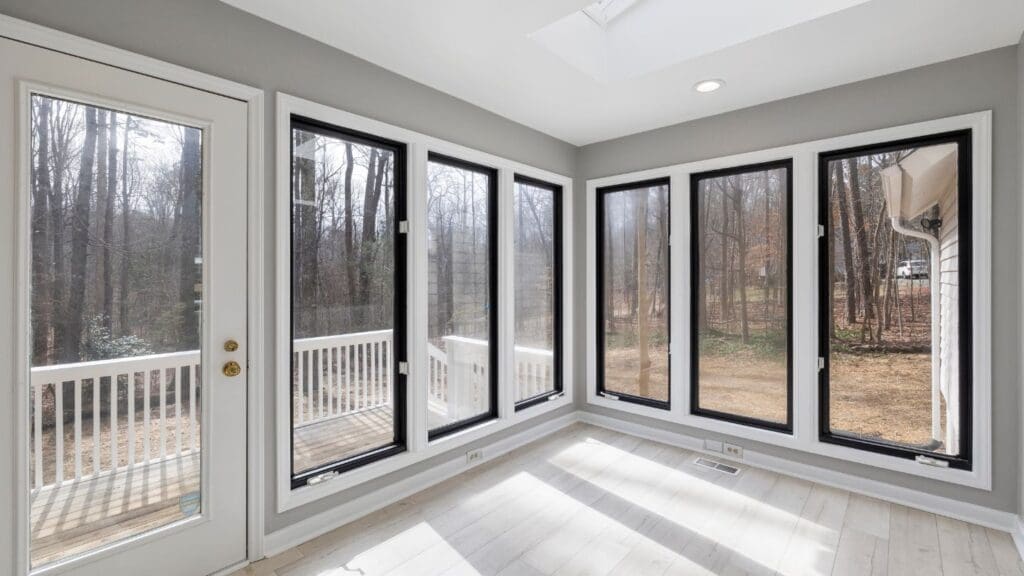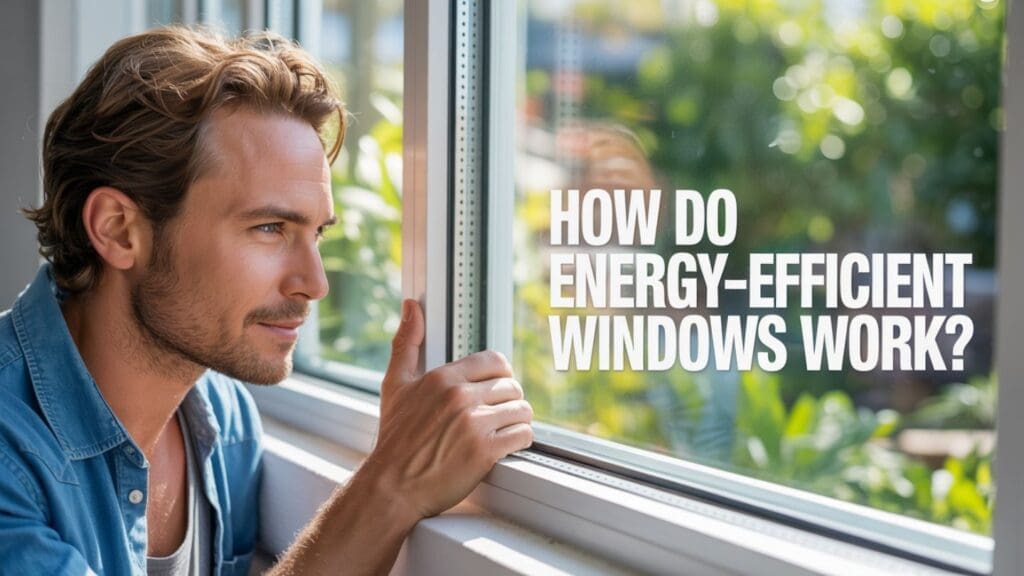Energy-efficient windows work by minimizing heat transfer between your home’s interior and the outdoors. But how do energy-efficient windows function? They achieve this through several key components such as low-e coatings, gas fills, and insulated frames. These features help to maintain a comfortable indoor climate while reducing energy consumption and also make the inside of your home more quiet.
Key Takeaways
- Energy-efficient windows feature advanced components like low-e coatings, gas fills, and multiple panes to minimize heat transfer and enhance insulation, leading to significant energy savings.
- Key metrics for evaluating window efficiency include U-factor, Solar Heat Gain Coefficient (SHGC), and Visible Transmittance (VT), which help determine thermal performance and energy costs in different climates.
- Installing energy-efficient windows improves indoor comfort, reduces energy bills, reduce outside noise and can increase home value while also requiring regular maintenance to ensure their long-term performance.
What Makes a Window Energy-Efficient?
Energy-efficient windows are designed with several advanced features that distinguish them from traditional windows. These include low-e coatings that minimize heat transfer and control the amount of daylight passing through, enhancing overall thermal performance. An energy-efficient window can significantly improve your home’s energy efficiency.
Additionally, the use of argon or krypton gas fills between glass panes significantly improves insulation and reduces heat transfer in addition to making the inside of you home more quiet. Modern energy-efficient windows also feature vinyl or composite frames, which offer excellent moisture resistance and superior thermal performance, while warm-edge spacers reduce condensation and further improve insulation.
Together, these features contribute to significant energy savings and improved comfort in your home’s energy efficiency, helping you save energy.
Energy-efficient windows and doors do more than cut your utility bills; they play a major role in reducing environmental impact. Understanding how energy-efficient windows and doors benefit the planet can guide homeowners toward more sustainable building choices that support both comfort and conservation.
Understanding Energy Performance Ratings
Energy performance ratings are crucial for evaluating the efficiency of windows. Key organizations involved include:
- The National Fenestration Rating Council (NFRC) tests, certifies, and labels windows based on their energy performance to help consumers make informed choices.
- ENERGY STAR, which contributes to these ratings by ensuring windows meet specific performance standards.
- The U.S. Department of Energy, which also helps ensure windows comply with performance standards based on climate zones.
Metrics and factors crucial for assessing energy efficiency include:
- Heat transfer rates
- Insulation properties
- Energy Star certification, which requires windows to meet rigorous NFRC ratings, guaranteeing their efficiency and suitability for various climates.
U-Factor
The U-factor measures the rate of heat transfer through a window and is a critical metric for assessing insulation effectiveness, especially in colder climates. A lower U-factor indicates better thermal performance and energy efficiency, helping to keep heat inside during winter and reducing the need for additional heating. Additionally, understanding u factors can further enhance energy efficiency in building design.
This not only enhances comfort but also contributes to significant energy savings by lowering heating costs, making it an energy saver.
Solar Heat Gain Coefficient (SHGC)
The Solar Heat Gain Coefficient (SHGC) measures the amount of solar radiation that passes through a window, affecting cooling costs in warmer climates. A lower SHGC rating is preferred in hotter regions as it reduces the amount of solar heat entering the home, thereby lowering cooling loads and energy costs.
This metric is essential for maintaining energy efficiency by minimizing escaping heat and keeping heat from the sun.
Visible Transmittance (VT)
Visible Transmittance (VT) measures the amount of visible light passing through a window, striking a balance between natural light and energy efficiency. A higher VT rating allows more natural light into the home, reducing the need for artificial lighting while minimizing glare and heat.
This feature not only enhances indoor illumination but also contributes to better thermal performance.
How Do Energy-Efficient Windows Function?

Energy-efficient windows are designed to create barriers that minimize heat transfer between indoor and outdoor air. These windows help maintain consistent indoor temperatures by preventing heated or cooled air from escaping, eliminating hot and cold spots, and reducing uncomfortable drafts. This regulation of interior temperature leads to a more comfortable living environment and significant energy savings.
Essentially, energy-efficient windows function by reflecting heat in the summer and retaining heat in the winter, ensuring optimal thermal performance year-round.
Preventing Heat Transfer
Several advanced components in energy-efficient windows prevent heat transfer. Multiple panes, typically double or triple-pane windows, provide additional layers of insulation compared to single-pane options. The spaces between these panes are often filled with argon or krypton gas, which enhances insulation and reduces heat transfer.
Low-E (low emissivity) glass is another critical feature, as it significantly reduces infrared light and UV light penetration, helping to maintain interior temperatures and prevent fading of furniture and fabrics. By combining these elements, energy-efficient windows achieve superior thermal performance and contribute to lower energy costs, thanks to the low-e coating.
Blocking UV Rays
Low-E glass reduces UV light transmission, blocking harmful rays while allowing visible light to pass through. This not only protects interior furnishings from fading but also contributes to overall energy efficiency by minimizing heat gain from solar radiation.
Effectively reducing UV exposure, these windows reduce UV rays and help maintain a comfortable and well-protected indoor environment.
Reducing Air Leakage
Designed to minimize air leakage, energy-efficient windows maintain indoor temperature and reduce energy consumption. Features such as tight seals, insulated frames, and effective weatherstripping help prevent drafts and improve overall energy efficiency.
Awning and casement windows are particularly effective in reducing air leakage due to their design, which presses the sash tightly against the frame when closed, creating a robust seal.
Types of Energy-Efficient Windows

There are various types of energy-efficient windows available, each offering unique benefits and energy-efficient features. Common materials used for constructing these windows include:
- Wood
- Vinyl
- Composite (Fibrex®)
- Fiberglass
Each material contributes differently to the window’s thermal performance.
Double-pane and triple-pane windows provide additional insulation, with triple-pane options offering even better energy savings, though they may take longer to recover initial costs. The choice of frame material and construction process also plays a crucial role in determining the overall energy efficiency of the windows, especially when considering triple-pane glass.
Choosing the right window isn’t just about aesthetics; it’s about performance. Knowing how to choose energy-efficient windows for your Houston home ensures your investment is tailored to local climate conditions, maximizing energy savings and long-term durability.
Double-Hung and Sliding Windows
Double-hung windows and sliding windows are popular styles in residential buildings, each offering distinct advantages. Double hung windows provide excellent ventilation and are versatile in design, making them suitable for various architectural styles.
Sliding windows, which open horizontally, are beneficial in spaces where vertical openings are impractical and offer easy operation and maintenance. Equipped with a double sliding window or triple panes and insulated frames, both window types enhance thermal performance, while sashes slide horizontally.
Casement and Awning Windows
Casement and awning windows are hinged windows that offer superior sealing capabilities:
- Casement windows are hinged on the side.
- They open outward.
- They create a tighter seal against air leaks when closed.
- This results in improved energy efficiency compared to other window types.
Awning windows, hinged at the top, allow for ventilation even during rain, protecting interiors from weather elements while maintaining energy efficiency. Both styles minimize air leakage and enhance overall thermal performance.
Picture and Bay Windows
Picture and bay windows are designed to maximize natural light and provide aesthetic appeal. Picture windows are fixed and do not open, offering unobstructed views and excellent insulation. Bay windows, consisting of three or more panels, create additional interior space and enhance natural light, contributing to better energy efficiency through improved insulation.
These window types are ideal for enhancing the visual appeal of a home while providing significant energy savings.
Benefits of Installing Energy-Efficient Windows

Installing energy-efficient windows offers a multitude of benefits beyond just energy savings. These windows improve home comfort by maintaining consistent indoor temperatures and reducing drafts. They also enhance the home’s market value due to their superior performance and lower operational costs.
Regular care and maintenance significantly enhance the durability and performance of these windows, ensuring long-term energy savings and comfort.
Lower Energy Bills
These windows can reduce energy bills by up to 13%. Installing Energy Star-certified windows leads to substantial savings on energy costs by reducing the need for heating and cooling. Double-pane windows, for instance, can lower a household’s carbon footprint by reducing CO2 emissions annually, ultimately impacting monthly energy bills.
They are an excellent investment for homeowners aiming to save money and enhance energy efficiency.
Enhanced Comfort
Energy-efficient windows enhance comfort levels by maintaining consistent indoor temperatures year-round, even in cold climates. Features such as Low-E glass and insulated frames reduce energy loss, making the home more comfortable by eliminating drafts and cold spots.
Higher VT ratings allow more natural light into the home, reducing reliance on artificial lighting and improving indoor illumination.
Noise Reduction
One of the often-overlooked benefits of energy-efficient windows is their ability to insulate against outside noise. These windows create a quieter indoor environment by reducing the transmission of external sounds, contributing to a more peaceful and comfortable living space.
Increased Home Value
Replacing old windows with energy-efficient models can significantly increase a home’s market value and curb appeal. Energy-efficient windows are attractive to potential buyers due to their superior performance and the promise of lower energy bills.
This investment not only saves money but also enhances the overall value and attractiveness of the home.
Maintaining Your Energy-Efficient Windows
Maintaining energy-efficient windows is crucial for preserving their performance and longevity. Regular cleaning and inspections help keep these windows functioning efficiently, ensuring they continue to provide energy savings and comfort.
Proper maintenance can also prevent issues like condensation and seal failures, which can compromise the windows’ effectiveness.
Regular Cleaning and Inspection
Maintaining the performance of energy-efficient windows requires regular cleaning and inspection. Non-abrasive solutions and soft cloths help avoid damaging the special coatings.
Regular inspections can identify potential issues early, ensuring that the windows continue to function efficiently over time.
Recognizing When to Replace
Recognizing when energy-efficient windows need replacement is crucial. Visible wear, significant rot or frame damage, and condensation between panes indicate it’s time to consider replacement.
Generally, windows should be evaluated for replacement every 20 years to ensure continued energy savings and performance.
Final Thoughts
Energy-efficient windows offer a comprehensive solution for homeowners aiming to reduce energy bills, stabilize indoor temperatures, and increase property value. With advanced features like low-e coatings, insulated frames, and multiple panes, these windows provide long-term benefits through improved comfort, noise reduction, and lower utility costs. Understanding their performance metrics and maintenance needs helps ensure you make an informed, value-driven investment in your home.
At Advanced Window Products, we specialize in helping homeowners find the right installations for energy-efficient windows in Houston tailored to local climate needs. Our windows are designed to deliver lasting performance, curb appeal, and measurable energy savings, ensuring your investment adds real value.
Frequently Asked Questions
What makes a window energy-efficient?
Energy-efficient windows are characterized by low-e coatings, gas fills between panes, and insulated frames, which significantly reduce heat transfer and enhance thermal performance. Prioritizing these features can lead to greater energy savings and comfort in your home.
How do energy-efficient windows reduce energy bills?
Energy-efficient windows lower energy bills by improving insulation and preventing air leakage, which helps maintain stable indoor temperatures and reduces the demand for heating and cooling.
What is the U-factor, and why is it important?
The U-factor is a measure of heat transfer through a window, and it is important because a lower U-factor signifies improved insulation and energy efficiency, helping to cut heating costs in colder climates.
How often should energy-efficient windows be replaced?
Energy-efficient windows should typically be replaced every 20 years, or sooner if you notice any signs of wear, damage, or reduced efficiency. Regular evaluation can help maintain optimal performance.
What types of energy-efficient windows are available?
Energy-efficient windows include double-hung, sliding, casement, awning, picture, and bay styles, each providing distinct advantages in insulation and energy savings. Selecting the right type can significantly enhance your home’s efficiency.
